If you’re anxious to kickstart the spring color in your yard and garden, scillas are an excellent planting option. They produce their true blue flowers very early in the spring. Some cultivars send up growth as early as January or February. They are versatile in terms of placement, are very hardy, and are easy to care for and propagate. If you’d like to add color to your landscape before the leaves have even appeared on the trees, you should consider planting some scilla bulbs.
| Botanical Name | Scilla sp. |
| Common Name(s) | Bluebell, squill |
| Popular Options | Siberian squill (Scilla siberica); Alpine squill (Scilla bifolia); Glory-of-the-snow (Scilla forbesii) |
| When to Plant | Summer to fall, depending upon chosen species |
| Sunlight | Generally, full sun, but many species tolerate part shade |
| Water | Soil should usually be kept moist, but not wet, throughout the growing season. Never allow standing water |
| Soil Conditions | The soil must be well-draining. Average fertility soil is generally preferred. Some species require poor, rocky soils. |
| Hardiness | Generally, winter is hardy down to USDA Zones 4. Some are hardy down to Zone 2. |
| Beginner Friendly? | Yes. A very hardy plant with simple care requirements. |
| Special Considerations | Considered potentially invasive. Aggressive spreader, by self-seeding as well as bulb offsets. |
What is Scilla Bulbs?
The genus Scilla belongs to the asparagus family. It is made up of around 100 species of bulb-forming, perennial, flowering plants that are native across Europe, Africa, and Asia. Ranging in height from 2-24 inches, these plants bear deep to pale blue, usually, bell-shaped flowers on arching stems. Flowers may be single or racemous. They may also be white or pink depending on the species.
While many other spring flowers are born from structures such as corms, rhizomes, or tubers, scillas produce true bulbs. This means that they store their nutrients in underground structures that are made of thick, modified leaf tissue. Inside the many layers of special storage leaves, the plant produces embryonic leaves, stems, and flowers. They will quickly emerge when above-ground conditions are ideal.
There are many species of Scilla in cultivation across the world. While a few species begin producing flowers in the summer and fall, the majority are late winter and early spring bloomers.
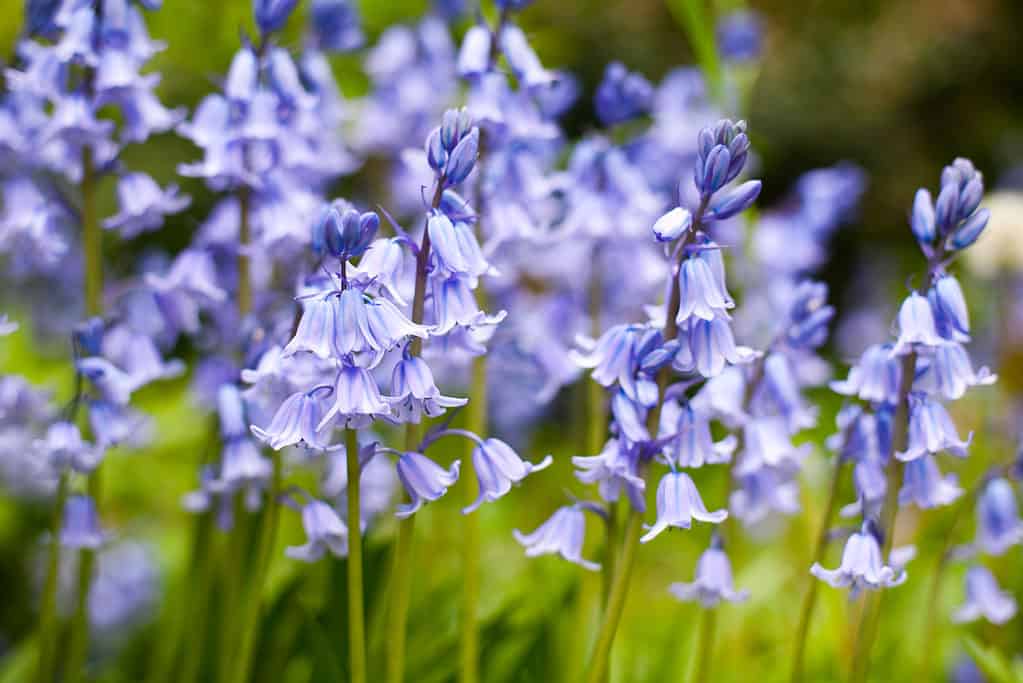
The genus
Scillais made up of around 100 species of bulb-forming, perennial plants with bell-shaped flowers.
©iStock.com/TylaArabas
Scilla Bulbs for Your Garden
Siberian squill is one of the most commonly cultivated species, along with Glory of the Snow (Scilla forbesii). Alpine squill (Scilla bifolia), and white squill (Scilla mischtschenkoana) are also common.
Because their foliage appears so early in the year and lasts such a short time before it dies back, these Scilla bulbs are very versatile members of the spring garden. They are commonly planted beneath deciduous trees and shrubs. While these locations become increasingly shaded throughout the spring and early summer, there is ample sun before the appearance of the year’s leaves. Once these sites become shaded out, plants like ferns and caladiums can take over the space.
Similarly, because most scillas also go dormant so early in the year, they can be planted in sunny locations among — and sometimes directly on top of — other spring bulbs. They will not interfere with their growth. This practice can help create a seamless transition of color in the garden. As the softer-colored scillas die back, they are replaced with bolder colors and larger foliage of flower bulbs that bloom later in the spring.
If you are interested in planting scillas in your garden this year, you may wish to try out one of the following cultivars:
Siberian squill (Scilla siberica)
This diminutive species of squill blooms for 2-3 weeks, bringing color into the garden very early in the spring. It produces very small, deep blue, bell-shaped flowers that are born atop arching stems, either singly or in racemes of 2-3. Because they only grow to heights of 3-6 inches, these delicate little plants make their greatest impact when grown in long, spreading drifts.
Scilla siberica is one of the most common scillas in cultivation. It is a hardy addition to the temperate spring garden. Because it can withstand cold temperatures down to USDA Zone 2, it requires no special winter care. It is this characteristic, along with its early flower and seed production, that allows the Siberian squill to so easily naturalize itself in non-native environments.
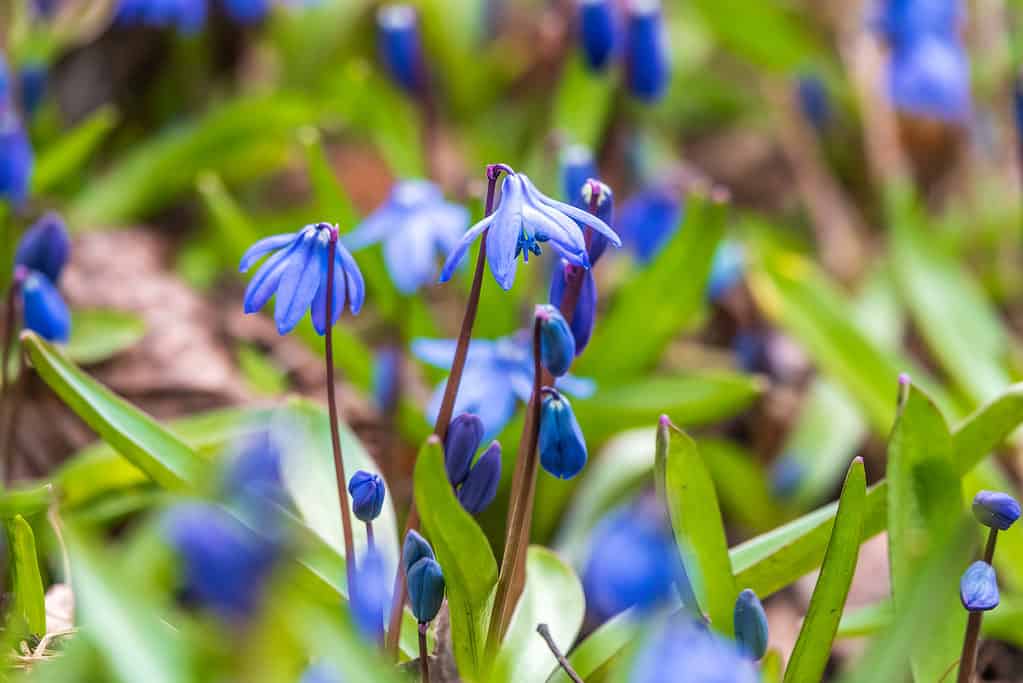
Siberian squill (
Scilla siberica) blooms for 2-3 weeks, bringing color into the garden very early in the spring.
©iStock.com/Dmitry Potashkin
Alpine squill (Scilla bifolia)
The alpine squill, like the Siberian squill, is a small, cold hardy species of Scilla. They are native to central and southern Europe and eastward to Turkey. While usually similar in size and color to the Siberian squill, these plants produce many more flowers on average and may even be found in white-colored variants. In the early spring, each plant bears several stems, each of which carries a raceme of 2-10 flowers. They usually produce only two leaves at the base of each stalk — a trait for which they have earned their other common name, the twin-leaf squill.
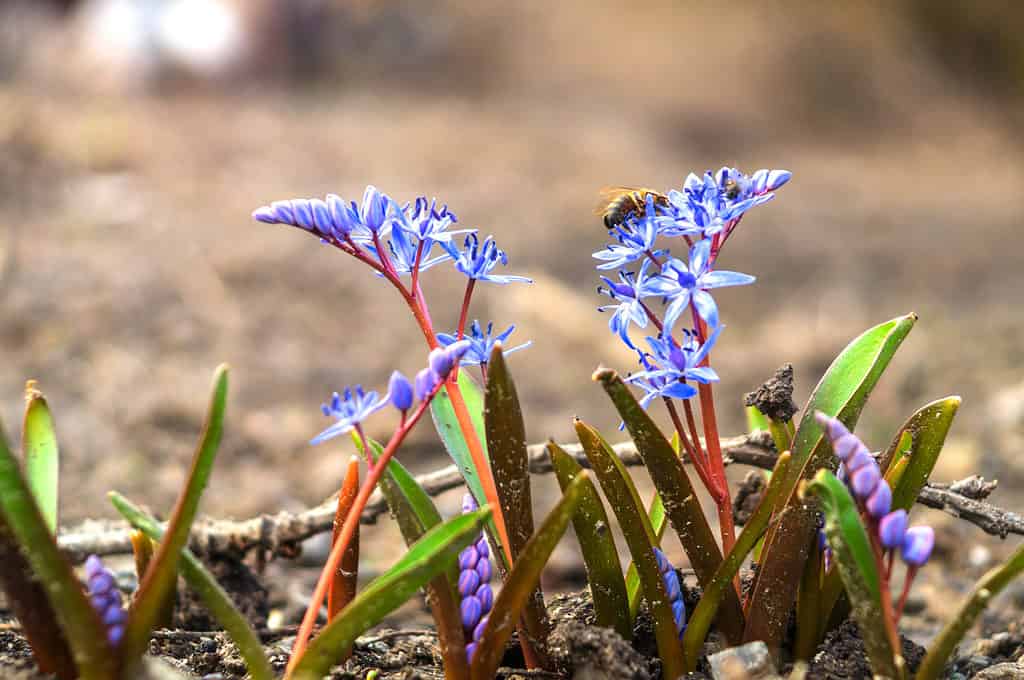
In the early spring, the alpine squill bears several stems, each of which carries a raceme of 2-10 flowers.
©iStock.com/VITALII BORKOVSKYI
White squill (Scilla mischtschenkoana)
Native to northern Iran and the Caucasus mountain range, this species of Scilla produces small, six-petal, very pale-blue or white flowers in the late winter and early spring. While they are not quite as cold-hardy as the other two species, they are still able to survive winter temperatures down to USDA Zone 4.
The fitting trend with the other low-growing squill cultivars, these plants are commonly grown in lawns, beds, or underneath deciduous trees in large, spreading drifts.
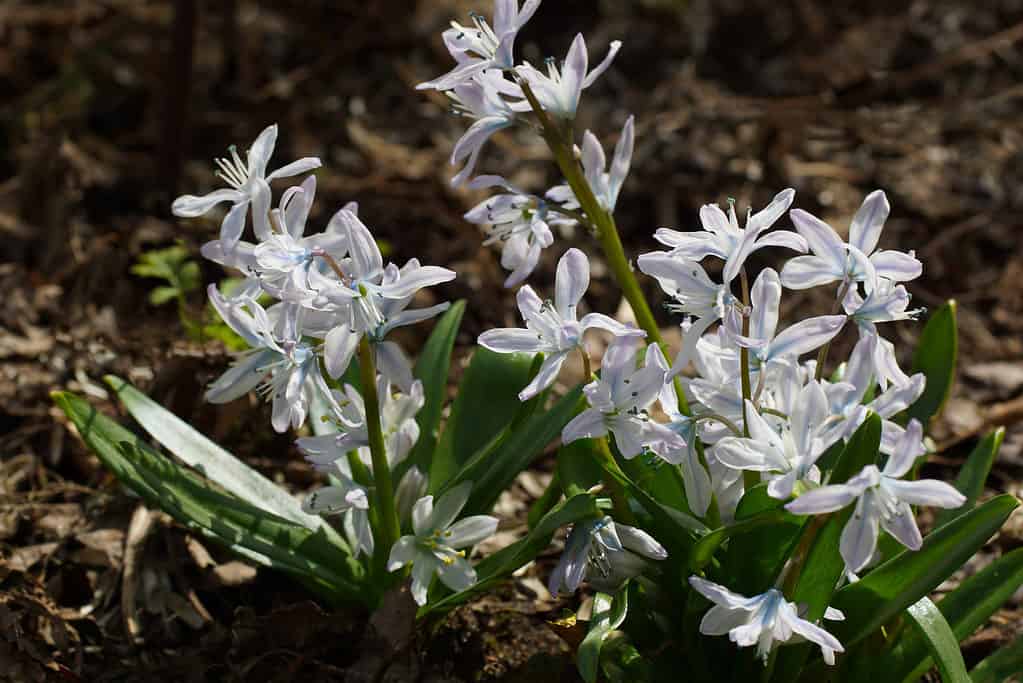
produces small, six-petal, very pale blue or white flowers in the late winter and early spring.
©iStock.com/Natali22206
Glory-of-the-Snow (Scilla forbesii)
Glory-of-the-snow, previously a part of the genus Chionodoxa, is another very commonly grown species of Scilla. Its visually striking, blue to bluish-purple, white-centered flowers are borne on racemes in similar quantity to those of the alpine squill. Each flower has six pointed tepals and measures, on average, one inch in length. While still considered small in stature, this species of scilla grows to heights of up to 7 inches.
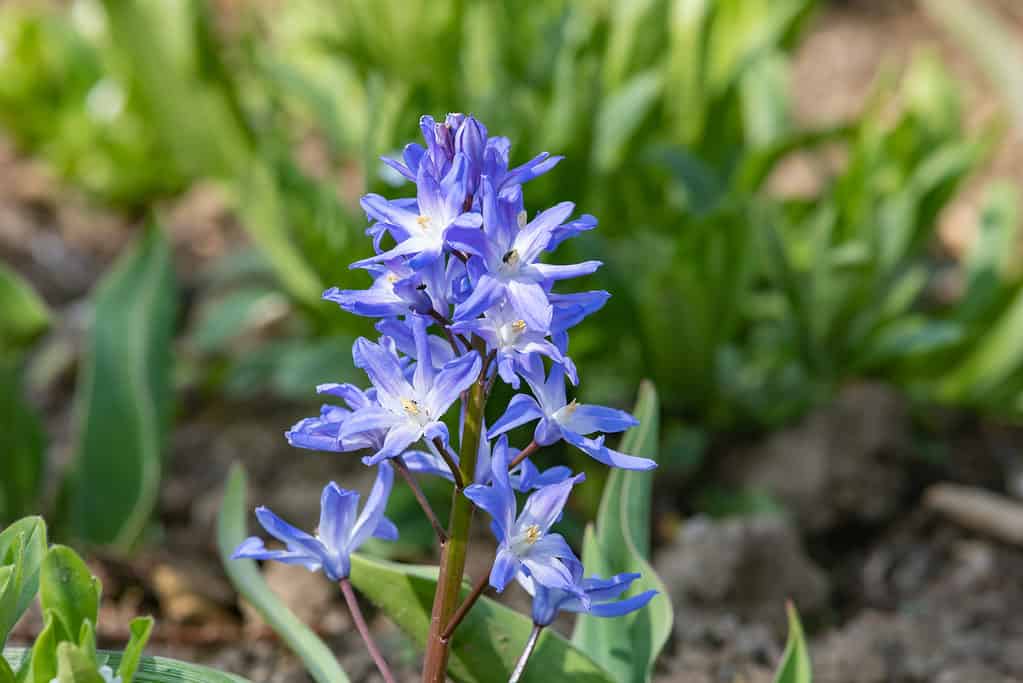
Glory-of-the-snow (
Scilla forbesii) produces striking, blue to bluish-purple, white-centered flowers.
©iStock.com/Tom Meaker
How to Care for Scilla Bulbs
Although scillas are generally vigorous and hardy, you can help your plants produce their best growth by keeping the following tips in mind. Care requirements may vary depending on your chosen cultivar, so be sure to look into specifics when planting.
Planting
Scillas are most commonly planted in the summer or fall in large groups, or drifts, to naturalize them in their new home. This practice creates a dense, blue carpet of flowers during their blooming period. To achieve this effect, gardeners plant bulbs in the autumn at an average density of 20 bulbs per square foot of garden space. Each bulb should be set in a hole that is between 2 and 3 inches deep and about 2 to 4 inches from other bulbs. When planting, you must place Scilla bulbs in the ground with their pointed end up.
Care should be taken when choosing a planting site. Due to their adaptable nature and strong ability to self-propagate, scillas can spread quickly and can overtake other local plant populations if grown in favorable conditions. It is recommended that a close eye be kept on these plants toward the end of the growing season and at the beginning of the next. Unintentional spread is possible. Their seeds mature quickly after the flowers have bloomed and they generally produce many bulb offsets each season.
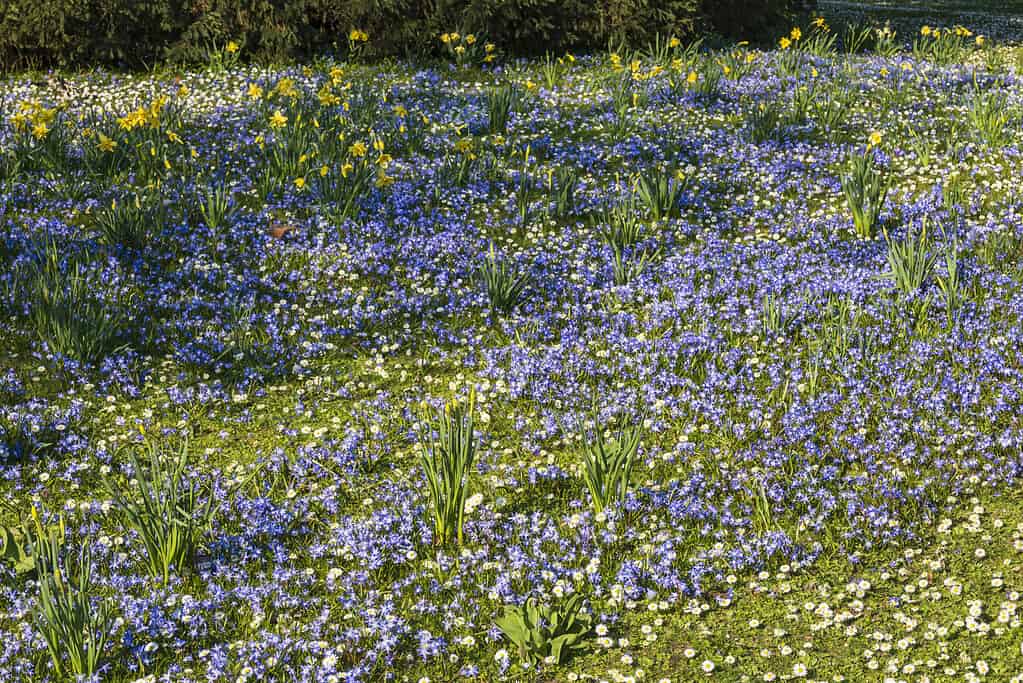
Scillas are most commonly planted in the summer or fall in large groups creating a dense, blue carpet of flowers during their blooming period.
©iStock.com/Harald007
Sunlight
Like most other spring bulbs, scillas generally produce their best growth when planted in an area that receives 6-8 hours of full sun per day. They can tolerate partial shade as well, but may not produce as many blooms.
Water
Most scillas prefer that their soil be kept moist throughout the growing season. Scilla plants grow quickly and require a lot of moisture to produce healthy leaves, flowers, and bulb growth. This is not always the case. Watering routines should be adjusted to fit the requirements of your chosen cultivar. In any case, care should be taken to avoid over-watering. Wet or over-saturated soil can create an anaerobic environment that encourages bulb rot and root rot.

plants grow quickly and require a lot of moisture to produce healthy leaves, flowers, and bulb growth.
©iStock.com/Yevheniya Tuzinska
Soil Conditions
Like other flowering bulbs, most Scilla species do best in fertile, well-draining soil. Some species, however, like Scilla hyacinthoides, do better in poor, rocky soils and require very little moisture. Confirm the specific needs of your chosen cultivar when choosing a soil composition and planting site.
In general, though, if the garden soil is particularly heavy and contains a large amount of clay, it should be amended to improve drainage and texture. The addition of more organic material, such as compost or well-rotted manure, can help accomplish this. Some aggregate can be added as well.
Pest Resistance
Luckily, scillas are resistant to the vast majority of browsing mammals. Because they produce very bitter chemical compounds that can cause immediate mouth pain and skin irritation, animals like deer and rabbits tend to avoid them. That being said, ingestion of any part of the plant will cause the same sorts of pains in humans, pets, and livestock as well. The glycoside compounds contained in the plant can also cause vomiting, cramping, diarrhea, and decreased heart rate if consumed in large enough quantities.
Due to their extremely unpleasant flavor and immediate oral irritation, however, it is very unlikely for ingestion to occur in high enough quantities to cause serious effects.
End-of-Season Care
Because of their vigorous nature and winter hardiness, Scilla bulbs do not need much help at the end of the growing season to produce new growth in the following years. Although not necessary, some steps can be taken to help them along.
Propagation
Scilla bulbs generally need no help from the gardener to reproduce. In fact, due to their virility, many gardeners are concerned with preventing unwanted propagation. These bulbs readily produce offsets and viable seeds and can spread rapidly and aggressively when unchecked.
If aiming to prevent unwanted spread, you should mow down flowers before they can produce seeds. You can also dig up and dispose of a portion of your garden’s Scilla population each year.
If you are just getting started and are impatient to fill up your Scilla bed or densify your drifts, their bulbs can be intentionally propagated in just the same way as other flowering bulbs. Bulbs are dug up at the end of the growing season. New offsets, or bulblets, are carefully separated from the parent plant. Each of these tiny offsets, once planted, will eventually grow to become full-sized Scilla bulbs. You can plant their seeds as well.
Storage
Because Scilla bulbs are such vigorous growers and are cold-hardy in the majority of USDA Growing Zones, there is generally no need to lift them for winter storage. If one expects extreme cold, leave fall leaves in place or apply mulch to the growing area to help insulate the soil.
The photo featured at the top of this post is © iStock.com/Mike_Colwill
Sources
- NC State Extension, Available here: https://plants.ces.ncsu.edu/plants/scilla-mischtschenkoana
- Pacific Bulb Society, Available here: https://www.pacificbulbsociety.org/pbswiki/index.php/Scilla
- Missouri Botanical Garden, Available here: https://www.missouribotanicalgarden.org/PlantFinder/PlantFinderDetails.aspx?taxonid=255514
- Missouri Botanical Garden, Available here: https://www.missouribotanicalgarden.org/PlantFinder/PlantFinderDetails.aspx?taxonid=281910
- University of Florida Gardening Solutions, Available here: https://gardeningsolutions.ifas.ufl.edu/plants/ornamentals/is-this-a-bulb.html
- Master Gardener Program University of Wisconsin-Extension, Available here: https://mastergardener.extension.wisc.edu/files/2015/12/Scilla_siberica.pdf
- University of Minnesota Extension, Available here: https://extension.umn.edu/identify-invasive-species/squill
- NC State Extension, Available here: https://plants.ces.ncsu.edu/plants/scilla-siberica
Thank you for reading! Have some feedback for us? Contact the AZ Animals editorial team.






